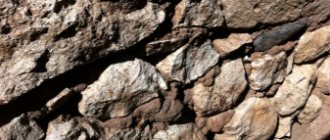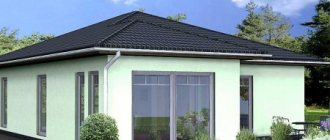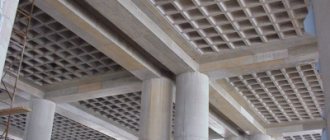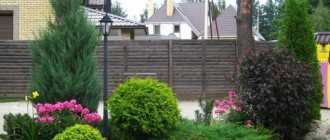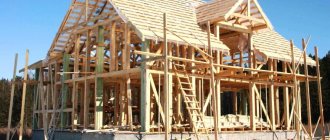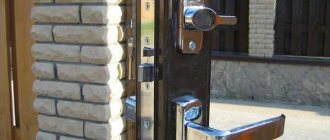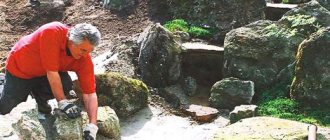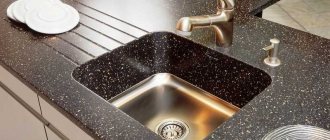On the modern market there is not only a large selection of technologies that allow people with different levels of income to build, but also a lot of materials that reduce the cost and speed up the process. If in the recent past bricks held total leadership, today various blocks and even slabs have taken the lead. One of the most interesting materials that is actively conquering the market is wood concrete panels, from which users of the FORUMHOUSE portal are also building houses.
What is wood concrete
What is wood concrete? The word arbolite comes from the Latin arbor, “tree” and litos, “stone”. On our territory (i.e. the former Union) it is called wood concrete, and abroad - wood concrete. Wood concrete includes sawdust, and wood concrete only includes wood chips.
Wood concrete is a material consisting of a mixture in which cement is used as a binder base (instead of cement there can be lime, magnesium binder), organic filler (wood chips), and a small amount of chemical additives.
Positive aspects of the material
One of the most important advantages of wood concrete is its environmental friendliness. This is a building material that is safe for human health. Its composition and production are also absolutely safe, including for the environment. And chemical additives have long been used for the benefit of humanity. For example, an additive such as aluminum sulfate is used for effective water purification at water treatment plants.
The main advantages of wood concrete are: Increased heat and sound insulation, which is achieved due to the porosity of the material, which eliminates the need for additional insulation. Absolute fire resistance - due to the fact that wood chips are surrounded by a thick layer of concrete. Strength. The production technology gives wood concrete high bending strength coefficients. That is, where other material cracks, wood concrete will remain unharmed. Only under heavy loads can this material deform, but also quite slowly, since wood chips have binding functions.
Plasticity is achieved again thanks to the wood filler, so wood concrete is not susceptible to damage during transportation, installation, as well as exposure to natural factors (soil vibrations, temperature changes, etc.) Lightweight compared to conventional materials (brick, concrete), which makes work easier for laying blocks. Durability. Wood concrete does not rot and is slightly affected by fungus, mold and chemicals. It is easy to change the shape of the block using a saw or an ax, and driving in nails and screwing in self-tapping screws even without dowels will not present any difficulties.
Its disadvantages
Experts highlight the disadvantage of this material associated with high water absorption, so its use in rooms with high humidity or in areas where precipitation predominates is not recommended. This in no way means that the structure will collapse after rain, like a house of cards, but the service life of the building will be reduced significantly. To avoid this, you need to take some measures to waterproof the structure during the construction stage.
If you use blocks for the foundation, then you definitely need waterproofing and they need to be located at least 0.5 m above the ground level. If you use wood concrete in roof construction, then you must protect the walls from rain with overhangs. Plaster or other finishing will protect the outdoor units from the effects of rain and snow. Among the shortcomings, one can also highlight the imperfect shape of the block, which affects installation and finishing. However, some enterprises began to produce tongue-and-groove blocks, which make it possible to increase their adhesion area, thereby reducing the seams and making installation easier.
Conclusion
In essence, wood concrete slabs are a construction kit from which a durable, warm and environmentally friendly box is assembled at record speed.
The key to a smooth assembly process is a carefully thought out and calculated project. On the websites of the slab manufacturer there are algorithms for calculating walls in cubic meters. A lot of interesting ideas, practical advice and original solutions can be found on the FORUMHOUSE portal.
Details of the construction of houses made of arbolite slabs are in the forum topics “Two two-story houses made of arbolite panels...” and “House made of arbolite panels.” In the article about façade rejuvenation there is a whole selection of materials for all occasions, including cladding for a house made of wood concrete slabs. Ideas for interior decoration can be suggested by articles about modern interior materials, mud plastering or self-leveling floors. The video is about a house made of wood concrete panels for an IT specialist, the construction of which took place thanks to FORUMHOUSE.
Subscribe to our Telegram channel Exclusive posts every week
Description and features
The composition of wood concrete includes:
- filler - wood chips, quite strictly limited in size, as well as crushed rice straw, flax seeds, cotton stems, and even pine needles and bark;
- binder – cement of the appropriate brand. This depends on the expected strength of the material, but not lower than M300;
- chemical additives - provide a better connection of components, rapid hardening, and so on. Mainly chloride salts of potassium, calcium, aluminum, as well as “liquid glass” are used.
Wood chips and cement are materials that are difficult to combine with each other, so it is very important to observe all the features of the production technology, in particular, thorough and long-term mixing of the initial mixture.
- The raw material is no less important: the size of the chips is important - no more than 25 mm in length and 10 in width, a certain degree of roughness, the type of wood - spruce, pine, beech, and even the nature of the wood - early or late. If all GOST standards are observed, the material turns out to be porous, “breathable”, but at the same time durable.
- The composition of the starting components affects the result to no less extent. For thermal insulation material, the ratio is usually as follows: 1 share of binder, 1 share of wood chips and 1.5 shares of water, or rather, a solution with salts. To obtain a structural material, the proportion of binder increases within certain limits.
- During production, it is not the proportions that are regulated, but the resulting properties of wood concrete. If they comply with GOST or TU, then the composition is considered suitable for use.
Making wood concrete
Making wood concrete blocks on your own site is not at all difficult. For this you need sawdust, cement, lime or clay, sand. You will also need concrete mixers and molds of the required sizes to pour the mixture.
Let's consider the stages of manufacturing sawdust concrete . The required proportions are shown in the table.
- Sift the sawdust through a sieve with a mesh size of 1x1 cm.
- Add sifted sawdust and sand to the concrete mixer. Mix well.
- Prepare liquid cement-lime mortar in a separate container.
- Pour the solution into a concrete mixer and mix the resulting composition thoroughly.
- We pour everything into molds.
Wood concrete blocks made in this way are removed from the mold after a couple of days, and after that they must gain strength within 30 days in a dry room.
Building blocks of grades 5 and 10 are used for insulation, higher grades are used for the construction of walls.
The disadvantage of wood concrete is that it absorbs moisture well, so it must be protected from precipitation. This can be done using plastering. You can plaster the walls only after the structure has completely settled, which is about six months, otherwise the plaster may burst.
A more reliable, but also more expensive method is the use of penetrating waterproofing
Small monolithic structures can be built from sawdust concrete. To do this, first construct the formwork of the required design, into which a mixture of wood concrete is poured.
It is necessary to pour in layers, no more than 15 cm, and each layer must be well bayoneted and compacted.
Such monolithic sawdust concrete gains strength within 3 months.
Wall design
The wall pie made of wood panel slabs consists of the following layers:
- ABOUT
facing part. Located in front of a structural wall. It can be represented by any decorative panels or blocks, or made of brick, concrete (grade M500 and higher). - A structure made of wood or high-quality steel, to which facing slabs were attached.
- Waterproofing layer. It is necessary due to the increased absorption of water by the material, as it protects against external atmospheric influences.
- Wood concrete panel. Installed on top of each other, with fastening along the grooves, using anchor fasteners.
- Waterproofing layer (optional). You can use roofing felt.
- Ventilation gap (20-40 mm). Improves microcirculation of air in the walls.
- Insulation (if desired). We recommend mineral wool or eco-cotton products foiled on one side. But you can also use polystyrene material.
- Reinforced mesh, with cells 30-50 x 30-50 (mm).
- A layer of plaster material, and then finishing putty.
Arbolite walls need wooden supports and high-quality plastering - this will help them last longer.
Some porous wood concrete slabs are produced with a finished facing layer , which is made of sand-cement plaster, with a thickness of 1.5 cm. Such products greatly facilitate the work with external finishing. The total wall layer should normally be 400-600 mm.
The thickness of the structural pie of the wall can also include layers of applied mortar. The use of cement-sand or adhesive mixture cannot be more than 20 mm.
Compound
The wood concrete mixture may contain various components. According to GOST 19222-84, wood concrete must consist of several components.
Organic filler – wood chips. To obtain quality blocks, wood particles with dimensions not exceeding 30, 10 and 5 mm in length, width and thickness, respectively, should be used. In addition, the content of polysaccharides in wood should not exceed 2%. The organic filler should not contain fungal elements or various mechanical inclusions. Depending on the type of wood concrete, the wood chip content ranges from 75 to 90%.
Cement binder. Portland cement of a grade not lower than M400 should be used as such a filler. Some manufacturers offer blocks made from frost-resistant cement. It should be noted that during long-term storage, cement blocks lose their original characteristics, which is why they may not meet the requirements stated by the manufacturer.
To avoid such a problem, experienced builders recommend buying wood concrete made of cement no lower than grade M500.
Components of chemical origin. Arbolite blocks partly consist of organic fillers, which tend to rot. To avoid damage to wood chips by fungus, various chemical additives are added to the mixture. These may be calcium or ammonium chlorides, aluminum sulfate or other inorganic substances. Such components are harmless to human health. They allow not only to protect wood chips from premature deterioration, but also to speed up the process of adhesion of the components of the wood concrete mixture, while reducing the drying time of the blocks.
Water is also used to create wood concrete. Its quality is regulated by GOST 23732-79. The water should not contain fats, lipid derivatives, or coloring components. Only fresh liquid is used to produce blocks.
Before starting the technological process, water and chemical components are subjected to laboratory tests. They are carried out regularly for each newly received batch.
| Wood concrete brand | Cement(M400) | Quantity of lime | Quantity of sand | Number of sawdust | Resulting density, (kg/m3) |
| 5 | 1 | 1,5 | — | 15 | 300-400 |
| 10 | 1 | 1 | 1,5 | 12 | 600–700 |
| 15 | 1 | 0,5 | 2,5 | 9 | 900–1000 |
| 25 | 1 | — | 3 | 6 | 1200–1300 |
How to do it yourself?
The technological process of creating AB begins with cutting wood chips; for this, only raw wood is used. Then it settles, treated with chemicals to remove sugars. Only raw chips provide a chaotic arrangement in the concrete mass, which is very important for obtaining rigidity and affects the amount of cement.
Standard composition of the solution for creating 1 m3 of arbolite blocks:
- chemical reagents - 10 kg;
- cement - 250 kg;
- wood chips - up to 300 kg.
There are several instructions for creating an arbolite mixture; it is important to remove moisture and sugar from the wood chips as much as possible. When they get into an alkaline cement mortar, due to hydrolysis they are converted into water-soluble sugar, which destroys concrete.
Washing sugar out of wood using reagents:
- slaked lime;
- Na2O(SiO2)n;
- Al2(SO4)3.
These reagents fill the pores of the chips, thereby reducing their ability to absorb water, which reduces the deformation of the block due to swelling/shrinkage cycles, which reduce the overall strength of the AB.
So, how to make wood-concrete material :
- The working mass is mixed in a concrete mixer.
- The molds are filled with the mixture using shovels and compacted using a timber device.
- The compaction process begins after laying the full form and additionally on top of a small mound.
- Experts do not recommend compacting each layer of mass; the more chaotically it is filled in the molds, the better the compaction will be.
- The mass is left in the molds for 3 days.
- Disassemble the forms and dry the AB in air.
A detailed guide to making wood concrete blocks is here.
Kinds
According to GOST 19222 84, wood concrete, depending on density, is divided into:
thermal insulation - with an average density of up to 500 kg/m3;
structural - with an average density of over 500 to 850 kg/m3.
Thermal insulation is used as non-load-bearing partitions, in the construction of light one-story buildings, as insulation.
Structural is used for the construction of load-bearing walls in low-rise construction (up to 3 floors).
Arbolite, depending on its compressive strength, is divided into classes:
B0.35; B0.75, B1 - for heat-insulating wood concrete;
B1.5; B2; B2.5; B3.5 - for structural wood concrete.
The compressive strength indicator is characterized by brands:
M5, M10, M15 - for heat-insulating wood concrete;
M25, M35, M50 - for structural wood concrete.
Manufacturers produce several types of this class of concrete. They will be discussed below.
- Building blocks. This group includes thermal insulation and structural materials. These components are used in various fields. The first has a low density, due to which it is used for laying a thermal insulation base during the construction of interior floors. The design option has a density approximately equal to 800 kg / cubic meter. m (due to higher cement content). Due to its higher strength, such wood concrete is used for the construction of load-bearing walls and supporting structures.
- Arbolite slabs. Used as a heat-insulating material. Their density does not exceed 500 kg/cubic meter. m.
- Blocks with decorative cladding. Such products can be finished with marble chips or facing tiles. These materials are much more expensive than conventional blocks. However, the structure with which it was erected does not require further work on the decorative finishing of the façade.
- Solution. It is prepared directly on the construction site and cannot be stored. The solution is used to create monolithic products. Most often it is used for insulating residential premises, much less often - for the construction of small structures. In addition, permanent formwork is made from it for structures whose height does not exceed 3 floors.
- Gypsum wood concrete. Its difference from the usual one is the use of gypsum in the production, instead of Portland cement. It has significant advantages: it does not require the use of chemical components and hardens quickly.
Like any certified building materials, block wood concrete is available in certain sizes. The most popular products are those in the shape of a parallelepiped with parameters of length, width and height equal to 500, 300 and 200 mm, respectively.
Armopoyas
To tie the structure together and increase the strength of the building, a concrete reinforced belt is poured on top along the entire perimeter. For a one-story house, it will become the basis for the rafter system; for the second floor, it will become a support for slabs or floor joists and walls made of slabs, the assembly of which is carried out in the same way as the first floor, after the final maturation of the reinforced belt.
Specifications
The main technical characteristics of wood concrete are presented in the table
| Index | Filler – wood chips |
| Average density, kg/m3 | 500 — 850 |
| Compressive strength, MPa | 0,5 – 3,5 |
| Bending strength, MPa | 0,7 – 1 |
| Modulus of elasticity, MPa | 250 – 2300 |
| Thermal conductivity, W/(mS) | 0,08 – 0,17 |
| Water absorption,% | 40 — 85 |
| Frost resistance, cycle | 25 – 50 |
| Shrinkage, % | 0,4 – 0,5 |
| Fire resistance | 0.75 – 1.5 h |
| Sound absorption, 126 – 2000 Hz | 0,17 – 0,6 |
| Biostability | 5 group |
Let's now take a closer look at these characteristics.
Density is a fundamental factor in the construction of structures. According to GOST 19222 84, in the production of wood concrete, instead of wood chips, you can use such fillers as hemp and flax kernels, crushed cotton stalks and crushed rice straw. The average density of wood concrete, depending on the type and class, as well as the type of filler, is indicated in the table.
| Type of wood concrete | Compressive strength class | Axial compressive strength grade | Average density, kg/m3, of wood concrete per | |||
| chopped wood | flax fire or crushed cotton stalks | hemp bonfire | crushed rice straw | |||
| Thermal insulation | B0.35 | M5 | 400-500 | 400-450 | 400-450 | 500 |
| B0.75 | m10 | 450-500 | 450-500 | 450-500 | ||
| B1.0 | M15 | 500 | 500 | 500 | ||
| Structural | B1.5 | — | 500-650 | 550-650 | 550-650 | 600-700 |
| B2.0 | M25 | 500-700 | 600-700 | 600-700 | — | |
| B2.5 | M35 | 600-750 | 700-800 | — | — | |
| B3.5 | M50 | 700-850 | — | — | — | |
Comparison of density with other building materials:
| Construction material | Density, kg/m3 |
| Arbolit | 400 – 850 |
| Tree | 450 — 600 |
| Aerated concrete | 600 — 800 |
| Foam concrete | 200 — 1200 |
| Silicate brick | 1700 — 1950 |
| Ceramic brick | 1550 — 1700 |
| Expanded clay concrete | 350 — 1800 |
Although the density of wood concrete is not high, thanks to this, the finished structure will weigh much less than a brick one. And if the weight of the building is light, then you can save on the foundation.
Strength means the threshold value of impact above which the destruction of the material occurs. For example, a cube of wood concrete 150*150*150 (mm) with a density of 600 kg/m3 will withstand a load of more than 8 tons. Important characteristics are bending strength (0.7 - 1 MPa) and elasticity (up to 2300 MPa). Thanks to this, wood concrete stands out from other building materials. Cellular concrete blocks or bricks are brittle materials.
Technology of building a house from arbolite panels
In order to build a house from panels, at the first stage you need to select a project. Next, a foundation is laid on which the panels can be installed. Floor beams are laid on top; the roof will be placed on them. The facade will immediately need to be protected from external influences, only then can interior decoration begin.
The algorithm for carrying out the work is generally the same as when using any other materials, but there are some features of the work. For example, the foundation should be slightly higher so that it does not come into contact with ground moisture, like the walls, because they are hygroscopic. Wood concrete is lightweight, so the foundation can be deepened not so much, having reached the soil freezing line. The base is additionally insulated and protected from moisture.
Installation of the panels is quite simple. They are manufactured in industrial conditions and delivered to the construction site. You will need to select a standard size and order lifting equipment. Wood concrete is very plastic, so it will not shrink after the building is erected.
As soon as the roof is created, you need to take care of distributing the load on the walls. The armored belt, which is located on the panels, will help you with this. The roof can be tiles and its varieties. Once the walls have been completed and the roof has been erected, you can begin finishing. For cladding, you can use all kinds of materials - from siding to plaster.
The layer of mortar between the blocks should be as thin as possible, this will reduce its consumption, and the strength of the structure will be at its best. The structural surface of the blocks will ensure good adhesion, which is impossible with other products with a smooth surface. The blocks have little weight, so you can do the work yourself, which cannot be said about the panels. The most unsuitable solution option is a cement-sand composition. Perlite mixture is more suitable, and the ideal solution would be adhesive for cellular concrete. The last two options have good heat resistance, and the adhesion ability is high enough to lay a thin, but at the same time strong seam.
Popular manufacturers and average cost of production
Wood concrete, although lightweight, is still concrete, and therefore it is more profitable for the builder to contact the nearest manufacturer, if, of course, the quality of its products is really worth a good word. Very often, wood concrete is produced using a rather artisanal method, which significantly affects its properties and its reputation.
Most often, companies offering the construction of buildings from wood concrete produce it themselves
- - one of the largest manufacturers in Russia, produces more than 1000 cubic meters. The cost of finished blocks depends on the type of material: the price of thermal insulating wood concrete per piece is 4600 rubles. per cubic meter m, and structural - from 5400 to 6200 rubles. per cubic meter m.
- The wood concrete products plant offers blocks of various sizes. The average cost of products is from 3600 rubles. per cubic meter m.
- The construction and trade company produces solid and hollow wood concrete at a price of 5,250 rubles. per cubic meter. The price here also includes delivery of the material.
- The Velizh house-building company has been producing wood concrete blocks since 2007. The cost of products is from 3900 rubles. per cubic meter m.
- The Vologda wood concrete plant offers structural wood concrete for 4,200 rubles. per cubic meter m.
History of wood concrete and wood concrete
Domestic experience in wood concrete production
According to the official version, wood concrete was first discovered by the Dutch in the 1930s. They developed a technology for producing a material called DURISOL. Representative offices of DURISOL appeared in Switzerland and Germany. Wood concrete using DURISOL technology, due to its characteristics and properties, has become known throughout Europe and North America.
Domestic experience in the production of wood concrete begins in 1960, when the Soviet Union, having copied the DURISOL technology, developed it based on GOST materials. Russian wood concrete passes all technical tests, even becoming standardized and certified in the USSR. More than a hundred factories for the production of wood concrete are being built on the territory of the Union, and the material is beginning to be used for the construction of factory buildings, rural houses and farms.
An interesting fact is that in the 60s, wood concrete panels were used in the construction of three buildings and a canteen in Antarctica, at the Molodezhnaya station. Despite the climate, the thickness of the walls was only 30 cm, and this was enough.
In the 80s, the Soviet Union developed a target program called “Arbolit”. Under this program, factories producing building materials begin to operate with a production capacity of 500 thousand m3 per year, and more than 3 thousand buildings are built from Soviet wood concrete.
In the 1990s, a guideline was taken for the construction of houses from blocks and panels based on inorganic aggregate. Arbolite, despite its unique properties, was not widely used in Soviet large-scale housing construction. Some wood concrete factories were destroyed, others were repurposed, and in general this industry was destroyed. And those buildings that were built from wood concrete back in the 60s now stand without losing their original appearance and condition.
Foreign experience in wood concrete production
- DURISOL (Netherlands)
Currently, DURISOL has representative offices in 12 countries, incl. in the Republic of Belarus and the Russian Federation. DURISOL wood concrete consists of coniferous wood chips (80-90% of the total volume), which is treated with mineral additives and Portland cement.
- Duripanel (Germany)
in Germany it produces wood concrete blocks; along with blocks, it also produces wall panels. The panel has a three-layer structure, a rigid base inside and a smooth top layer on both sides. To make panels, wood fibers, mineral additives, water and Portland cement are used as a binder.
- Velox (Austria)
For 50 years, the Austrian company has been producing permanent formwork. The formwork consists of compressed spruce wood chips (95% of the total volume), cement, liquid glass and aluminum sulfate.
- Permax (Japan)
Wood-cement boards "Permax" are produced in Japan. Softwood blanks and waste from plywood production are used as filler, from which longitudinal chips are made on planing machines. The shavings are dried, after which the wood fiber is spread in an even layer on a special spreading machine and impregnated with cement mortar with the addition of mineralizers. In addition to wood fiber, wood chips are used for Permax boards. In Japan, about 20 million pieces of such slabs are produced per year, their production is also developing in neighboring countries (Thailand, Philippines, etc.)
- Centuryboard (Japan and USA).
, specializing in the sawmill industry, organized the production of fire-resistant boards for exterior decoration. The plates are coated with acrylic paint or synthetic resins and have a good appearance.
- Faswall (USA)
produces blocks that consist of Portland cement, wood chips and fly ash. The blocks meet all American standards and have been widely used for 60 years.
- Lignacite ltd (UK)
developed building blocks based on pine sawdust, sand and cement. The blocks are hollow, have good thermal insulation properties, are waterproof, fireproof, frost-resistant and bioresistant. They are used for external and internal walls in low-rise construction.
- Saw concrete (Slovakia)
An effective wall material has been developed in Slovakia. Sawn concrete consists of wood waste - sawdust and shavings from softwood, calcium chloride and Portland cement. It is used for the construction of agricultural and residential buildings, construction of attics. The environmental friendliness and durability of wood concrete allows it to be used in unexpected ways. In Great Britain, the production of birdhouses made of wood concrete was organized.
Optimal equipment for the production of wood concrete
If we quickly collect the prevailing options, we get the following picture:
- Disc wood chipper, DS31 (Belgorod). Factory price 199 thousand rubles.
- Advantages: compactness, mobility within the workshop.
- Disadvantages: dependence on power supply.
- Hammer chopper, DS31 (Stary Oskol). The average cost is 273 thousand rubles.
- Advantages: high productivity.
- Disadvantages: requires additional capacity for transporting wood chips within the workshop.
- Rotary chopper, BMP (Vologda). Prices within 230 thousand rubles.
- Advantages: combined type of wood chipper, high productivity.
- Disadvantages: a certain size of the receiving window, raw materials require adjustment in size.
- Mixing hopper, BMP (Vologda). Plant price 400 thousand rubles.
- Advantages: sufficient volume for commercial production.
- Disadvantages: Requires continuous loading to operate effectively, not suitable for small batches.
- Containers for liquids, IRPLAST (Irkutsk). Cost from 7 thousand rubles per 500 liters.
- Advantages: compact, different shapes, made of polyethylene.
- Disadvantages: it has to be modified for use with pumps
Naturally, everyone wants the equipment to be:
- powerful;
- compact;
- productive.
However, in reality this is not always the case.
The price of products varies depending on the materials and components used. Two engines of the same power, but produced with different safety margins, will have different prices. The cheaper one will definitely be at risk of breakdown.
The size of the loss is comparable to the cost of the chip cutter itself. Therefore, there is no point in buying a chip cutter that costs less than 150 thousand rubles; these are unreliable options. Equipment produced in Belgorod and Vologda is considered optimal in this industry.
